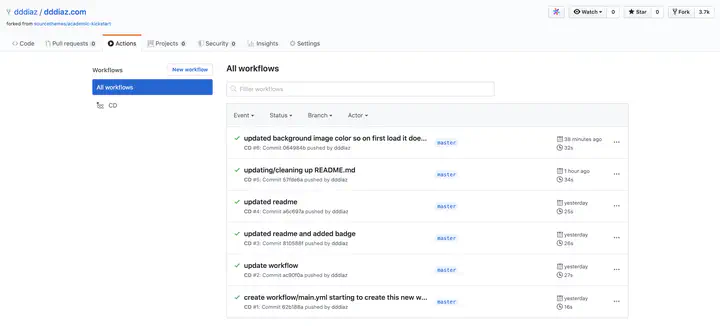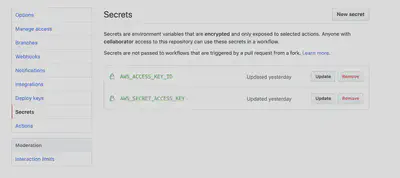Github Actions
Using Github Actions to deploy this site.
 Image credit: Daniel Diaz
Image credit: Daniel DiazBackground
dddiaz.com is a static website built with Hugo. Hugo is a super nifty framework that lets you easily create content in markdown, that can then be converted to html on build. Previously I used AWS Codestar to manage the various aws code* (codebuild, codedeploy, codecommit) resources to build and deploy my static front end and simple lambda backend. These resources handled the hugo build, hugo deployment to s3, and associated cloudfront cache clear. Cloudfront helps me globally distributes my website, which should slightly cut down on load times, but its cache needs to be reset on deployment. CodeStar also handled the backed lambda deployment process. While I enjoyed Codestar, and it had rock solid uptime, it was rather cumbersome. It was quite awkward to have to navigate into the AWS console to check the status of my current deployment.
Github Actions to the Rescue
Recently I noticed Github Actions, and wanted to see if that could help reduce some of the complexity around my build and deployment process, while giving me a chance to play with something new. Oh, and not to mention, it’s free!
So in the following lines, I am going to describe what I needed to do, and my overall conclusion.
Building the Action
Everything relating to github actions can actually be created in the github gui. In fact they have a super fancy editor for creating the action with intellisense.

They start you off with a template, which is easy to use as a jumping off point. From there, I knew the first hurdle would be my aws creds, as they are needed as part of my deployment.
Well wouldn’t you know it, AWS already posted a library for me to use, that makes this process seamless.
- name: Configure AWS credentials
uses: aws-actions/configure-aws-credentials@v1
with:
aws-access-key-id: ${{ secrets.AWS_ACCESS_KEY_ID }}
aws-secret-access-key: ${{ secrets.AWS_SECRET_ACCESS_KEY }}
aws-region: us-east-1
Now you might be wondering about the aws secrets, github has that handled too. There is a secrets portion of your repo where you can upload all your relevant secrets.

Now that aws has set up my creds and set up the aws cli, I need to build my actuall hugo website. Turns out there is an action I can import here too.
- name: Hugo Setup
uses: peaceiris/actions-hugo@v2.4.11
with:
# The Hugo version to download (if necessary) and use. Example: 0.58.2
hugo-version: 0.70.0
# Download (if necessary) and use Hugo extended version. Example: true
extended: true
- name: Hugo Build
run: hugo --minify
Last step is to upload to s3 and reset the cloudfront cache.
- name: Copy frontend files to S3 with the AWS CLI
run: |
aws s3 sync public <s3-bucket> --delete
- name: Clear Cloudfront Cache
run: |
aws cloudfront create-invalidation --distribution-id <your-distribution-id> --paths '/*'
And that’s it! Before you know it, you are doing one click deployments!
You can even create a badge to display on your main readme.

Whoa whoa whoa, this seem pretty easy, but what about that backend api you mentioned earlier. Ahh, glad you mentioned that.
Backend Action
Some background first, I have a backend api availble at https://api.dddiaz.com/birthday which contains super critical information on if it is my birthday ;)
It’s a simple python lambda that I can deploy with cloud formation. So, similar to above, I will create an action, then I will set up my aws creds, then instead of hugo build I will run the following aws commands.
# Runs a single command using the runners shell
- name: AWS CF Package
run: aws cloudformation package --template-file template.yaml --s3-bucket <your-bucket> --output-template-file packaged-template.json
# Runs a set of commands using the runners shell
- name: AWS CF Deploy
run: |
aws cloudformation deploy --template-file packaged-template.json --stack-name <your-stack-name>
And that’s it!
Here are the links to the full workflows if you would like to take a peak:
Conclusions
Pros:
- Free!
- Super Easy to work with and setup
- You can import other people’s libraries
- Surprisingly fast build
Cons:
- Vendor Lock In
I really liked Github Actions, and I am glad I decided to move to it. While the build syntax is very specific to github, I had that before with AWS CodeBuild. The advantage I have now though, is that its easy to see the status of my buid and deployment, and it doesnt cost me anything to run!